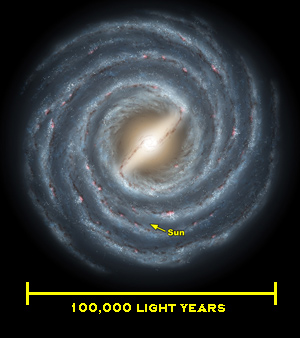There is just something wonderful when Hubble points to nearby spiral galaxies. Sprawling and detailed, we get both great resolution on smaller features as well as a jaw-dropping overview of a grand spiral… like, say, NGC 1073:
Yeah, I know. [Click to galactinate – I had to shrink it to fit here, and it lost a lot of the coolness when I did – or grab the 3900 x 3000 pixel version.]
NGC 1073 is a decent-sized spiral galaxy about 60 million light years away. It’s actually part of a small, tight group of galaxies many of which are far more famous (like NGC 1068). But 1073 is important because of a simple property: it looks like us.
 While it’s not a perfect match, NGC 1073 does bear an interesting resemblance to our Milky Way galaxy (UGC 12158 looks more like our galaxy, but is far bigger, for example). Both have large, rectangular bars going across their centers. Bars are a bit odd, since you’d expect the arms just to wind all the way down to the center. But the gravity of a galaxy isn’t like the gravity of a solar system, with a big heavy star sitting in the center. Galaxies have their mass spread out over a long distance, so what gas and dust clouds and stars feel in the way of gravity is different, and bars are a natural outcome of that. However, they’re still not perfectly understood. Bars may form when galaxies collide, and they might be an indication of a galaxy reaching middle age. Perhaps there are other factors as well.
While it’s not a perfect match, NGC 1073 does bear an interesting resemblance to our Milky Way galaxy (UGC 12158 looks more like our galaxy, but is far bigger, for example). Both have large, rectangular bars going across their centers. Bars are a bit odd, since you’d expect the arms just to wind all the way down to the center. But the gravity of a galaxy isn’t like the gravity of a solar system, with a big heavy star sitting in the center. Galaxies have their mass spread out over a long distance, so what gas and dust clouds and stars feel in the way of gravity is different, and bars are a natural outcome of that. However, they’re still not perfectly understood. Bars may form when galaxies collide, and they might be an indication of a galaxy reaching middle age. Perhaps there are other factors as well.
Studying galaxies like NGC 1073 will help us understand how bars form, and why we have one too. Remember, we’re stuck inside our galaxy and can’t see it from the outside (that picture above is an illustration based on detailed observations). It really helps our understanding of the Milky Way to observe galaxies like ours.
An important thing too is that the two galaxies are different in some ways: NGC 1073 has more open arms, for example, compared to our more tightly wound arms. Those differences are telling us something as well. What is it that makes one galaxy hold its arms closer in, and another to fling them out? Why does this galaxy have two arms, and that one three? If you can look at two galaxies that are alike except in one way, it’s easier to isolate the cause. So studying NGC 1073 is a great way to study ourselves.
It always makes me think of Nietzsche, who wrote on the nature of man, “And when you gaze long into an abyss, the abyss also gazes into you.”
But on the nature of the Universe, it changes: “And when you gaze long into an abyss, your gaze falls back on yourself.”
Related posts:
- The Milky Way’s (almost) identical twin
- Barred for life
- Unwind with some spirals
- Setting the bar
- Sculpting a barred galaxy